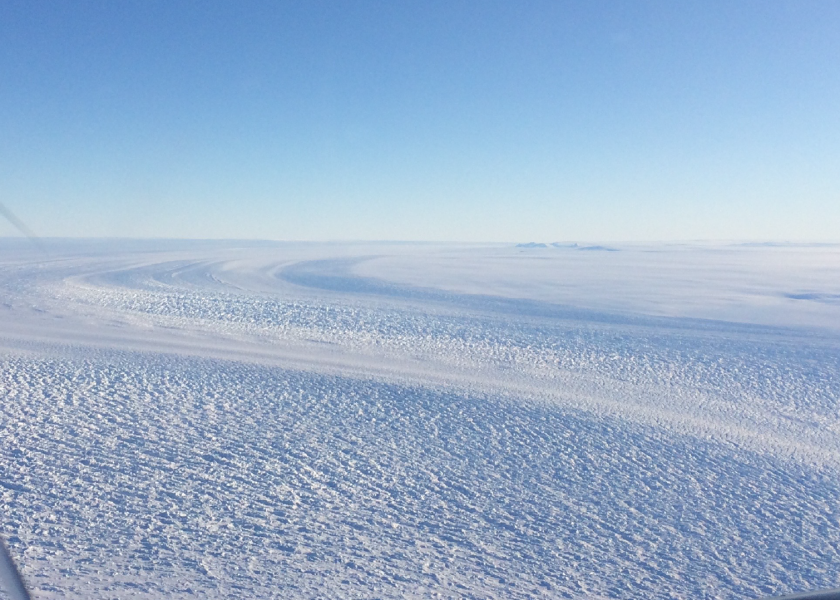UT-Led Aerial Surveys Reveal Ancient Landscape Beneath East Antarctic Ice Sheet
October 30, 2023

Long before Antarctica froze over, rivers carved valleys through mountains in the continent’s east. Millions of years later, researchers have discovered a remnant of this ancient highland landscape thanks to an aerial survey campaign led by the University of Texas Institute for Geophysics (UTIG).
The findings were described by researchers at Durham University and Newcastle University, UK, and were published Oct. 24, 2023, in the journal Nature Communications.

According to the research, the landscape of ancient valleys and ridges formed at least 14 million years ago. The find is unusual because the tremendous weight and motion of the overlying ice sheet should have ground it away.
Finding such a well-preserved landscape from before the continent’s glaciation gives researchers a geologic reference point to measure how quickly the ice sheet grew and how rapidly it will melt, said coauthor Duncan Young, a UTIG research scientist.
“This landscape hanging out there in the middle of the basin is a little bit of an odd phenomenon,” he said. “We’re now working to answer why it was preserved and use that knowledge to find others.”
Scientists are keen to learn about the land under Antarctica’s ice because it plays a vital role in the stability of the ice sheet. Some landscapes let ice flow rapidly to the ocean, others act to slow or bolster against intruding seawater. The land also records the history of how the ice sheet grew and retreated.
The basin where the ancient landscape was found contains enough ice to raise global sea level by more than 25 feet. But less is known about the land under the ice than the surface of Mars, said the paper’s lead author Stewart Jamieson, a professor in the department of geography at Durham University.
“And that’s a problem because that landscape controls the way that ice in Antarctica flows, and it controls the way it might respond to past, present and future climate change,” he said.
The more evidence researchers can find about how the ice sheet grew and retreated in the past the better they will understand how Antarctic ice will respond to ongoing global warming, he said.
The discovery of the landscape was made using satellite data and radio-echo sounding techniques to map a region of land underneath the ice sheet measuring 32,000 square-kilometers (12,355 square-miles, about the size of the state of Maryland). It builds on previous work by researchers to map out hidden mountain ranges, canyon systems and lakes beneath the ice in Antarctica.
Although the landscape is not visible to the naked eye, satellite images captured over the region show small undulations of the ice sheet’s surface. The landscape’s existence was confirmed by UTIG-led aerial surveys that used ice-penetrating radar to see through the ice and map the shape of the land beneath the ice sheet.

The research team believes that there are other undiscovered, ancient landscapes hidden beneath the ice sheet.
More could soon be identified thanks to a long-term effort to map unexplored regions of East Antarctica by Young and his collaborators, who have flown hundreds of flights since 2008 using a modified, WWII-era DC-3, equipped with ice-penetrating radar and other instruments.
Those surveys helped in the latest discovery and could lead to many more as scientists continue to comb the data.
“It’s a gift that keeps on giving,” said Young, who helped spearhead an initiative funded by the National Science Foundation to make the radar data available to the broader scientific community.
The research behind the latest discovery was supported by the UK’s Natural Environment Research Council (NERC), the G. Unger Vetlesen Foundation, NSF and NASA.
Other UTIG co-authors include Senior Research Scientist Don Blankenship, who led the first stage of aerial surveys, and Shuai Yan, a graduate student at The University of Texas at Austin’s Jackson School of Geosciences whose research turned up a lake hidden beneath the ice in another region of the basin. UTIG is a research unit of the Jackson School.
Adapted from “Ancient landscape discovered beneath East Antarctic Ice Sheet” published Oct. 24, 2023, by Durham University.
For more information, contact: Anton Caputo, Jackson School of Geosciences, 210-602-2085; Monica Kortsha, Jackson School of Geosciences, 512-471-2241; Constantino Panagopulos, University of Texas Institute for Geophysics, 512-574-7376.
